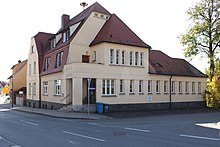Max Boehme
Max Böhme (born May 14, 1870 in Zeitz ; † November 18, 1925 in Coburg ) was a German architect and municipal building officer in Coburg.
Live and act
Böhme completed a degree in architecture at the Buxtehude building trade school . In 1898 he took up a position in the state building administration of the Grand Duchy of Hesse in Darmstadt . In 1899 he became the second city architect in Halle an der Saale and in 1903 he was appointed city architect in Coburg, where he was also able to gain the favor of the ducal house . The buildings designed in the Art Nouveau style in particular shape the Coburg cityscape to this day and are now among the listed buildings in the city.
Boehme's first building in Coburg in 1903 was the management building of the former municipal electricity works in today's Bamberger Straße 2 . His house in Gustav-Freytag-Weg 23 from 1904 followed as a second building. In the period from 1903 to 1905, Böhme was in charge of the renovation of the Coburg town hall and in 1906, as part of the Itz regulation, the design of the banks . In the same year, the Alexandrinenturm he had planned was inaugurated on the Senningshöhe.
The year 1907 was marked by the opening of a large number of buildings planned by Böhme. These were the heating center of the municipal gas station at Schillerplatz 1 , the crematorium and the urn hall as part of the expansion of the cemetery on Glockenberg , which he had been in charge of since 1903 , the Ernst-Alexandrinen-Volksbad and the Heilig-Kreuz-Schule . On April 29, 1907, Böhme was appointed town planning officer by Duke Carl Eduard .
The design of the former department store in Spitalgasse 19 from 1908 was a private commission from the textile department store chain M. Conitzer & Söhne like the bank building of the savings and aid association in Steinweg 5 in 1911. Other buildings by Böhme were the Herzogsbrunnen on the Hohe Schwenge in 1909 and in 1910 the raft bridge over the Hahn river. The water tanks Plattenäcker and Himmelsacker from 1914 completed his buildings in Coburg. In 1921, the city council approved a lifelong employment.
Despite his achievements, Böhme was also exposed to criticism when he asked for a salary increase in 1913, although he earned additional income from sideline jobs in Thuringia, such as the public bath in Römhild . He received an increase in salary to 6,500 marks, which rose to 7,500 marks in the following years. His additional income is documented by the Böhme Collection with pictures of his work in Thuringia in the Coburg City Archives.
He did not always find like-minded people with his plans and ideas, but thanks to his expertise, he knew how to assert himself. With regard to the cost increase in the construction of the Ernst-Alexandrinen-Bad, the Coburger Tageblatt wrote on September 8th: It is by no means an art to build pompously if you can take the money from other people's pockets unabashedly , which refers to the Duchess Alexandrine of Baden , had provided a large sum privately, was alluded to.
In 1924 Böhme retired for health reasons. He died a year later. His grave is in the Glockenberg cemetery. One street, the Max-Böhme-Ring on Bertelsdorfer Höhe in Coburg, was named after him in 1998.
literature
- Helmut Wolter: “In which style should we build?” Builders and architects from Coburg 1820–1920. (= Space - time - Coburg , volume 1.) Dr. Peter Morsbach Verlag, Regensburg 2011, ISBN 978-3-937527-38-3 .
Individual evidence
- ^ Government Gazette for the Duchy of Coburg, May 4, 1907
- ↑ Karl-Ulrich Pachale: Max Böhme (1870-1925). In: Coburger Geschichtsblätter Jahresband 2008. pp. 74–76.
- ^ Peter Morsbach, Otto Titz: City of Coburg. Ensembles, architectural monuments, archaeological monuments. Karl M. Lipp Verlag, Munich 2006, ISBN 3-87490-590-X (= Monuments in Bavaria. Volume IV.), S. CXXIX
- ^ Coburger Zeitung, April 3, 1913
- ^ Coburger Tageblatt, April 3, 1913
| personal data | |
|---|---|
| SURNAME | Böhme, Max |
| BRIEF DESCRIPTION | German architect and construction officer |
| DATE OF BIRTH | May 14, 1870 |
| PLACE OF BIRTH | Time |
| DATE OF DEATH | November 18, 1925 |
| Place of death | Coburg |


